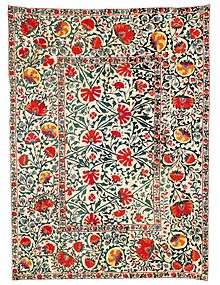Shahrisabz
|
Kok-Gumbaz mosque | |
| UNESCO World Heritage Site | |
|---|---|
| Location |
Qashqadaryo Region, Uzbekistan |
| Coordinates | 39°03′N 66°50′E / 39.05°N 66.83°E |
| Area | 240 ha (26,000,000 sq ft) |
| Criteria |
Cultural: (iii), (iv) |
| Reference | 885 |
| Inscription | 2000 (24th Session) |
| Endangered | 2016– |
 Location of Shahrisabz | |

Shakhrisabz (Uzbek: Шаҳрисабз Shahrisabz; Tajik: Шаҳрисабз; Persian: شهر سبز shahr-e sabz (city of green / verdant city); Russian: Шахрисабз), is a city in Qashqadaryo Region in southern Uzbekistan located approximately 80 km south of Samarkand with a population of 100,300 (2014).[2] It is located at an altitude of 622 m. Once a major city of Central Asia, it is primarily known today as the birthplace of 14th-century Turco-Mongol conqueror Timur.
History
Formerly known as Kesh or Kish (i.e., "heart-pleasing") and tentatively identified with the ancient Nautaca, Shahrisabz is one of Central Asia’s most ancient cities. It was founded more than 2,700 years ago. Its name was officially changed to Shahrisabz in the modern era.
From the 6th to 4th centuries BC it was a part of Akhemenid empire.
Alexander the Great's general Ptolemy captured the satrap of Bactria and pretender to the Persian throne, Bessus, at Nautaca thus ending the once great Achaemenid Empire. Alexander the Great chose to spend his winters and met his wife Roxanna in the area in 328-327 BC.
From 4th to 8th century Kesh was one of urban centers of Sogdiana. Between 567 and 658 rulers of Kesh paid taxes to khagans of Turkic and Western Turkic khaganates. In 710 the city was conquered by the Arabs.
Shahrisabz was the birthplace of Timur on April 9, 1336, to the family of a minor local chief, and during the early years of the Timurid Dynasty, enjoyed his considerable patronage. Timur regarded Shahrisabz as his “home town” and planned it eventually to be the location of his tomb. However, during his reign, the center of activity shifted to Samarkand instead.
According to legend, the Khan of Bukhara, Abdullah Khan II had the city destroyed in a fit of rage over the death of his favorite horse from exhaustion on a steep approach to the city, but was later overcome with remorse for the damage he had done.
The city struggled for autonomy under Bukharan rule. The Russians helped the Bukharan emir conquering the city in 1870.
Historical sites
Several remaining impressive monuments from the Timurid Dynasty have enabled the old part of the city to be inscribed on the UNESCO World Heritage List.
- Ak-Saray Palace
Timur's Summer Palace, the “White Palace” was planned as the most grandiose of all Timur's constructions. It was started in 1380 by artisans deported by Timur from the recently conquered Khwarezm. Unfortunately, only parts of its gigantic 65 m gate-towers survive, with blue, white and gold mosaics. Above the entry of the Ak-Saray are big letters saying: "If you challenge our power – look at our buildings!"
- Kok Gumbaz Mosque / Dorut Tilovat (Dorut Tilavat) Complex
A Friday mosque built in 1437 by Ulugh Beg in honor of his father Shah Rukh, its name meaning “Blue Dome”. Located immediately behind the Kok Gumbaz Mosque is the so-called “House of Meditation”, a mausoleum built by Ulugh Beg in 1438 but apparently never used for burials.
- Hazrat-i Imam Complex
East of the Kok Gumbaz is another mausoleum complex called Dorus-Saodat (Seat of Power and Might), which contains the Tomb of Jehangir, Timur’s eldest and favorite son. The adjacent mosque is said to house the tomb of a revered 8th century imam Amir Kulal.
- Tomb of Timur
Behind the Hazrat-i Imam Emsemble is a bunker with a door leading to an underground chamber, discovered by archaeologists in 1943. The room is nearly filled with a single stone casket, on which inscriptions indicate that it was intended for Timur. However, the conqueror was buried in Samarkand, not at Shahrisabz, and mysteriously, his tomb in Shahrisabz contained two unidentified corpses.
Also of interest are medieval baths and an 18th-century bazaar.
In popular culture
In 1980s the Uzbek Soviet band Yalla wrote a song about Shahrisabz.
See also
References
External links
| Wikimedia Commons has media related to Shahrisabz. |
| Wikivoyage has a travel guide for Shakhrizabz. |
- History and monuments of Shahrisabz
- Square Kufic decoration on Timur's Summer Palace
- Square Kufic decoration on the Dar al-Siyadah Complex
- Square Kufic decoration on the Dar al-Tilavah Complex
- Yalla - "Shahrisabz" on YouTube
.jpg)
